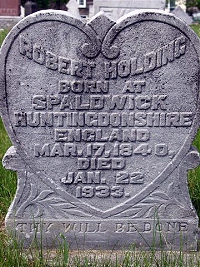|
If you enter the old Protestant Cemetery through the gate on Birch Street and angle off to the right, you will find a grey, heart-shaped grave-marker with a two-masted sailing vessel incised on the west side and on the side facing the rising sun, you can read:
|
Robert Holding
born at
Spaldwick
Huntingdonshire
England
Mar. 17, 1840.
Died
Jan. 22
1933
Thy Will Be Done
|

|
Like a ghost, Robert Holding flits through the pages of Vincent Crichton�s history, Pioneering in Northern Ontario, turning up here and there playing a variety of roles in Chapleau�s story.
To Holding himself, the most exciting event in his lengthy life undoubtedly came a few weeks after his 24th birthday while he was a seaman aboard the sailing vessel Invercauld.
On May 10, 1864, a storm battered the Invercauld to pieces on the rocky west coast of one of the uninhabited Aukland Islands, south of New Zealand. Nineteen members of the crew, including Holding, made it to shore. One year and 10 days later, when rescue finally came, only two were still alive �the Captain and seaman Robert Holding.
After being shipwrecked and marooned on a desert island for a year before his 25th birthday, the rest of Holding�s life risked being one long anticlimax. However, in Holding�s case, he was too busy to let that happen. He came to Canada in 1888, a man of 48 with a wife and children. By 1890 he was in Chapleau, working as a machinist in the C.P.R. shops.
Once in Chapleau, he built a tenement building on Beech Street to be a home for his family and a boarding house. It was known as �Crusoe House� after the hero of Daniel Defoe�s famous novel.
Holding�s service to Chapleau included serving for a time as an �ex-officio� policeman (as Vincent Crichton puts it) before the incorporation of the municipality in 1901. But undoubtedly his major contribution to the community was his leadership in setting up Chapleau�s first public school. Holding had barely arrived in town before he began to push for a proper school board. When the board was set up at a public meeting in February, 1891, Robert Holding, a man whose own �schooling had been very much neglected� and who had gone to sea at age 14, was elected chairman. The trustees moved quickly. Three months later, on May 21, 1891, they opened a one-room school house on the property at 21 Pine Street. There were nineteen students.
|
A more frivolous side of Holding�s character is revealed in Vincent Crichton�s account of a very boisterous July 1 celebration here in Chapleau. It happened some time in the first decade of the 20th century, when it was decided to re-enact the battle of San Juan Hill, a famous incident in the Spanish-American War (1898). Chapleau�s San Juan Hill was to be on the north side of the Kebsquasheshing River; the attackers would carry out an amphibious landing with the invasion flotilla coming from the south shore. Both sides would use home-made �cannon� loaded with sod propelled by real gunpowder. Old sea-dog Robert Holding commanded a �hospital ship� (flying a Red Cross flag) that followed the invasion fleet and picked up survivors from sunk or capsized craft.
Gold was another of Holding�s interests. As a young man he had prospected in Australia and in the early years of the 20th century, as he passed his 70th birthday, he again felt the bite of the gold-bug. Off he went into the bush �first around Dog Lake and Manitowick Lake and later around West Shining Tree. In 1913, in the latter area he found gold at the south end of MacDonald Lake and worked it for about a year before selling his claim.
Sixty-one years after his rescue, Holding painstakingly typed an account of his shipwreck and survival, and this became a key document when his great granddaughter, Madelene Ferguson Allen, set out to tell the story of his adventure in her book, Wake of the Invercauld.
In 1928, Robert Holding, by then 88 years old, began a career as hotel-owner when he acquired the Algoma (later the Hublit) Hotel on the corner of Young and Birch Streets by foreclosing on a mortgage. Holding�s son-in-law, Charles Vice, managed it for him.
Five years later, Robert Holding died and was buried in the old Protestant Cemetery.
Vincent Crichton tells of once meeting the old man on the river, fuming away at an inboard motor that had failed him. When Vincent offered to tow him, Holding refused, saying �This goddam boat brought me down the lake and this goddam boat is going to take me home�. It is difficult to recover the personality of a man from the surviving fragments of his story, but Holding�s own words give us some notion of the stubborn spirit that kept this Chapleau pioneer alive for over a year after being shipwrecked on a desert island in the South Pacific.
(Written by George Evans, largely based on material found in the book, Pioneering in Northern Ontario by Vince Crichton.)
|

